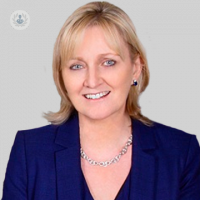TMS for fibromyalgia
Written by:Fibromyalgia is a condition that can cause severe musculoskeletal pain, fatigue and headaches. Although there is currently no cure, transcranial magnetic stimulation has emerged as one of the most effective ways to relieve symptoms and improve quality of life for those living with fibromyalgia.

We spoke to one of London’s top rheumatologists Dr Stephanie Kaye-Barrett about the functionality, success rates and risks of this treatment method.
How does transcranial magnetic stimulation work?
Transcranial magnetic stimulation (TMS) is a non-invasive technique that uses an electromagnetic field to target a very specific area of the brain. The treatment involves a series of “pulses”, delivered at one-second intervals, which cause neurons in that area of the brain to become stimulated. Treatment is delivered over a course of sessions, which has been found to give long lasting improvements for a number of different medical conditions.
How can transcranial magnetic simulation help with fibromyalgia?
Recent advances in brain scanning have allowed researchers to discover that certain regions of the brain, specifically those areas thought to be responsible for processing pain, are overactive in people suffering from fibromyalgia [1]. TMS inhibits this overactivity, helping to bring back normal levels of activity in these areas of the brain. Initial research has shown this to be effective in many cases, which is an incredibly exciting development for the estimated 2% of the population thought to suffer from fibromyalgia [2].
How many times can you have transcranial magnetic stimulation?
Our standard treatment protocol is for 20 sessions, and studies into the use of TMS for fibromyalgia suggest that people who respond should begin to do so after around five sessions. One study [3] included a six-month follow up, and found that the improvements were sustained throughout this time. Maintenance treatments can also be given, with the aim of “topping up” the effect, which, although not yet studied for fibromyalgia, has been shown to reduce the risk of relapse in people being treated for depression [4].
Are there any side effects?
TMS is generally very well tolerated, with a low risk of very mild side effects for most people. The most common of these is headache, which has been reported to affect around 10% of TMS patients, although it is usually brief and responds well to painkillers. Other reported side effects are neck stiffness and mild dizziness, although these are again usually short lasting [5]. A trained specialist will monitor you throughout treatment in the unlikely event that you need to stop the session. Although a relatively novel treatment for fibromyalgia, TMS has been used for other conditions for over 25 years, with an excellent safety record.
How successful is transcranial magnetic stimulation for fibromyalgia?
Currently there is no cure for fibromyalgia, with treatment instead focusing on symptomatic relief. A recent change to the NICE guidelines has also meant that painkillers are no longer routinely offered to people with fibromyalgia, as these were deemed to do more harm than good in many cases [6]. This has left many sufferers with very limited resources available with which to manage their condition. In the studies that have been done so far, TMS appears to be effective at both reducing pain, and improving quality of life in people with fibromyalgia, all without long-term medication or harmful side effects [7].
It must be noted, however, that as with all medical interventions, there are some people who appear not to respond to treatment. However, for the majority of people that do respond, this is an incredibly exciting breakthrough that could give hope to the millions of people who are suffering from this debilitating condition.
For expert treatment of fibromyalgia or any other rheumatological issue like gout, osteoporosis or arthritis, visit Dr Stephanie Kaye-Barrett’s Top Doctors profile, where you can view her scheduling information and request an appointment with her.
References:
1. van Ettinger-Veenstra, H., Boehme, R., Ghafouri, B., Olausson, H., Wicksell, R. K., & Gerdle, B. (2020). Exploration of Functional Connectivity Changes Previously Reported in Fibromyalgia and Their Relation to Psychological Distress and Pain Measures. Journal of clinical medicine, 9(11), 3560. https://doi.org/10.3390/jcm9113560
2. Heidari, F., Afshari, M., & Moosazadeh, M. (2017). Prevalence of fibromyalgia in general population and patients, a systematic review and meta-analysis. Rheumatology international, 37(9), 1527–1539. https://doi.org/10.1007/s00296-017-3725-2
3. Tanwar, S., Mattoo, B., Kumar, U., & Bhatia, R. (2020). Repetitive transcranial magnetic stimulation of the prefrontal cortex for fibromyalgia syndrome: a randomised controlled trial with 6-months follow up. Advances in Rheumatology, 60.
4. Richieri, R., Guedj, E., Michel, P., Loundou, A., Auquier, P., Lançon, C., & Boyer, L. (2013). Maintenance transcranial magnetic stimulation reduces depression relapse: a propensity-adjusted analysis. Journal of affective disorders, 151(1), 129–135. https://doi.org/10.1016/j.jad.2013.05.062
5. Rossi, S., Antal, A., Bestmann, S., Bikson, M., Brewer, C., Brockmöller, J. & Hallett, M. (2020). Safety and recommendations for TMS use in healthy subjects and patient populations, with updates on training, ethical and regulatory issues: expert guidelines.
6. https://www.nice.org.uk/guidance/ng193/chapter/Recommendations
7. Boyer, L., Dousset, A., Roussel, P., Dossetto, N., Cammilleri, S., Piano, V., ... & Guedj, E. (2014). rTMS in fibromyalgia: a randomized trial evaluating QoL and its brain metabolic substrate. Neurology, 82(14), 1231-1238.


